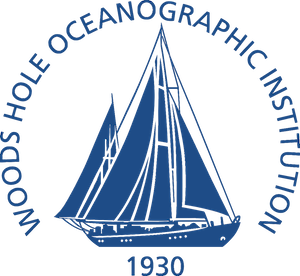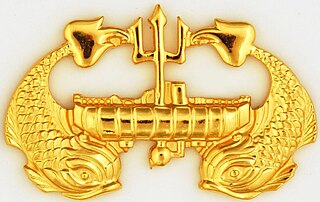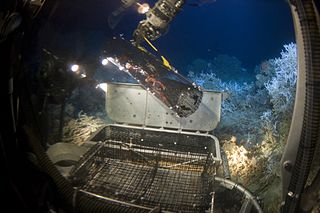Related Research Articles

Trieste is a Swiss-designed, Italian-built deep-diving research bathyscaphe. In 1960, it became the first crewed vessel to reach the bottom of Challenger Deep in the Mariana Trench, the deepest point in Earth's seabed. The mission was the final goal for Project Nekton, a series of dives conducted by the United States Navy in the Pacific Ocean near Guam. The vessel was piloted by Swiss oceanographer Jacques Piccard and US Navy lieutenant Don Walsh. They reached a depth of about 10,916 metres (35,814 ft).

The Woods Hole Oceanographic Institution is a private, nonprofit research and higher education facility dedicated to the study of marine science and engineering.

Alvin (DSV-2) is a crewed deep-ocean research submersible owned by the United States Navy and operated by the Woods Hole Oceanographic Institution (WHOI) in Woods Hole, Massachusetts. The original vehicle was built by General Mills' Electronics Group in Minneapolis, Minnesota. Named to honor the prime mover and creative inspiration for the vehicle, Allyn Vine, Alvin was commissioned on June 5, 1964. The submersible is launched from the deep submergence support vessel RV Atlantis (AGOR-25), which is also owned by the U.S. Navy and operated by WHOI. The submersible has made more than 5,200 dives, carrying two scientists and a pilot, observing the lifeforms that must cope with super-pressures and move about in total darkness, as well as exploring the wreck of Titanic. Research conducted by Alvin has been featured in nearly 2,000 scientific papers.

A bathyscaphe is a free-diving, self-propelled deep-sea submersible, consisting of a crew cabin similar to a Bathysphere, but suspended below a float rather than from a surface cable, as in the classic Bathysphere design.

A submersible is an underwater vehicle which needs to be transported and supported by a larger watercraft or platform. This distinguishes submersibles from submarines, which are self-supporting and capable of prolonged independent operation at sea.

A midget submarine is any submarine under 150 tons, typically operated by a crew of one or two but sometimes up to six or nine, with little or no on-board living accommodation. They normally work with mother ships, from which they are launched and recovered and which provide living accommodation for the crew and support staff.

The Deep Submergence Insignia is a uniform breast pin worn by officers, both men and a few women of the United States Navy's submarine service who are qualified in submarines and have completed one year of regular assignment to a Manned or Unmanned Deep Submersible. The badge was first approved on 6 April 1981.

A deep-submergence vehicle (DSV) is a deep-diving crewed submersible that is self-propelled. Several navies operate vehicles that can be accurately described as DSVs. DSVs are commonly divided into two types: research DSVs, which are used for exploration and surveying, and DSRVs, which are intended to be used for rescuing the crew of a sunken navy submarine, clandestine (espionage) missions, or both. DSRVs are equipped with docking chambers to allow personnel ingress and egress via a manhole.

Trieste II(DSV-1) was the successor to Trieste – the United States Navy's first bathyscaphe purchased from its Swiss designers.

Turtle (DSV-3) was a 16-ton, crewed deep-ocean research submersible owned by the United States Navy. It is sister to Alvin (DSV-2) and Sea Cliff (DSV-4).

Jason is a two-body remotely operated vehicle (ROV) designed, built, and operated by the National Deep Submergence Laboratory of the Woods Hole Oceanographic Institution (WHOI). Construction of Jason began in 1982 and was first launched in 1988, redesigned in 2002 as the second iteration of the ROV. The ROV allows scientists and explorers to have access to the seafloor without leaving the deck of a ship.

Aluminaut was the world's first aluminum submarine. An experimental vessel, the 80-ton, 15.5-metre (51 ft) crewed deep-ocean research submersible was built by Reynolds Metals Company, which was seeking to promote the utility of aluminum. Aluminaut was based in Miami, Florida, and was operated from 1964 to 1970 by Reynolds Submarine Services, doing contract work for the U.S. Navy and other organizations, including marine biologist Jacques Cousteau.

Deep-sea exploration is the investigation of physical, chemical, and biological conditions on the ocean waters and sea bed beyond the continental shelf, for scientific or commercial purposes. Deep-sea exploration is an aspect of underwater exploration and is considered a relatively recent human activity compared to the other areas of geophysical research, as the deeper depths of the sea have been investigated only during comparatively recent years. The ocean depths still remain a largely unexplored part of the Earth, and form a relatively undiscovered domain.
Jason Junior, also called JJ, was a small remotely operated vehicle (ROV) designed and built by the Deep Submergence Laboratory at the Woods Hole Oceanographic Institute (WHOI). Jason Jr. was a prototype for a larger, more capable ROV named Jason, which was being developed to complement the Argo unmanned undersea video camera sled.

Nereus was a hybrid uncrewed autonomous underwater vehicle built by the Woods Hole Oceanographic Institution (WHOI). Constructed as a research vehicle to operate at depths of up to 11,000 metres (36,000 ft), it was designed to explore Challenger Deep, the deepest surveyed point in the global ocean. Nereus, named for Greek sea titan Nereus through a nationwide contest of high school and college students, began its deep sea voyage to Challenger Deep in May 2009 and reached the bottom on May 31, 2009.

The Shinkai (しんかい) is a crewed research submersible that can dive up to a depth of 600 m. It was completed in 1970, and until 1981 it had the greatest depth range of any crewed research vehicle in Japan. The Shinkai is owned and run by the Japan Coast Guard and it is launched from the support vessel Otomemaru (乙女丸).

DSV-5, ex-NEMO, was a submersible used by the United States Navy between 1970 and 1986 to oversee and observe undersea construction work. NEMO had a spherical transparent acrylic hull, which gave occupants panoramic vision. NEMO was the first submersible with a hull made entirely out of transparent acrylic (Plexiglass), and much of her career was spent testing this hull design. NEMO was found to be an effective observation platform, despite not being able to hover in place, and acrylic-hulled submersibles have continued to be built and operated in the United States. NEMO is considered part of the Alvin class of Deep Submergence Vehicles despite bearing little resemblance to the other subs of the class. NEMO was transferred to "other government agencies" in 1986 and retired from government service in 2011. It was then given to the U.S. Navy Seabee Museum, where it remains on display.
Deep Sea Warrior bathyscaphe is a type of very little known deep-submergence vehicle built in the People’s Republic of China (PRC). Deep Sea Warrier was handed over from its builder China Shipbuilding Industry Corporation to its customer at the end of 2016, but actual deep diving did not begun until end of the following year due to preparation needed, because it was such as new product that thorough preparation was needed to ensure its safe operation, and bathyscaphye is capable of diving to a depth of 4500 meters.

Striver bathyscaphe is a type of deep-submergence vehicle built in the People's Republic of China (PRC). It was built by China State Shipbuilding Corporation (CSSC). It can accommodate three crew members, and is designed to reach depths of more than 10,000 meters. Striver is equipped with two mechanical arms, seven underwater cameras, seven sonars, hydraulic drills, and other scientific devices.
Autonomous Benthic Explorer (ABE) was a pioneering autonomous underwater vehicle (AUV) owned and operated by Woods Hole Oceanographic Institution (WHOI) in Woods Hole, Massachusetts. ABE was designed to perform wide-area seabed surveys at depths of up to 4500m (14,674ft) and completed 222 missions from 1996 until it was lost at sea in 2010. ABE pioneered the use of a relatively simple AUV to perform wide area surveys, identify points of interest, and “scout” for a more sophisticated manned vehicle or ROV.
References
- *This article includes information collected from the Naval Vessel Register , which, as a U.S. government publication, is in the public domain.The entry can be found here.
- ↑ "Turtle, Bathysphere (DSV-3), 1968, Hahn and Clay Co., Houston, Texas". Mariners' Museum and Park . 2022. Archived from the original on September 18, 2022. Retrieved September 18, 2022.
- ↑ REZA, H. G. (March 30, 1985). "Vessel Returns to Point Loma : Navy Vehicle Takes a Plunge to a Record Depth". Los Angeles Times. ISSN 0458-3035 . Retrieved December 21, 2017.
- ↑ "U.S. Navy Gives Woods Hole Oceanographic Institution Deep Diving Submarine". Woods Hole Oceanographic Institution. July 31, 1998.
- ↑ "No Name (DSV-4)". US Navy, NAVSEA Shipbuilding Support Office. 2019. Archived from the original on March 25, 2019. Retrieved June 24, 2023.
- ↑ Broad, William J. (September 1, 1998). "For Aging Ocean Explorer, a New Life at New Depths". The New York Times.
- ↑ "History of Alvin". Woods Hole Oceanographic Institution. 2023. Archived from the original on May 10, 2023. Retrieved June 24, 2023.
- ↑ "Underwater Vehicles". Woods Hole Oceanographic Institution. 2023. Archived from the original on May 14, 2023. Retrieved September 22, 2023.